It was a quarter past eleven in the night when we packed up and prepared to leave Manori. The scenes scheduled for the day had been canned. The marathi language film was nearing completion and only a day’s shoot remained. It was scheduled for completion the next day at Madh Island. Sanjay and I walked down to where he had parked his bike at the entrance to the Gagangiri Maharaj ashram and called someone on his cellphone while I waited, watching unit members leave the film location in ones and twos, and sometimes threes. They walked slowly, silent, thinking. Two dogs kept a wary eye on them from the side of the road. I listened to their footsteps as they made their way past me, heads loose on their shoulders, chins tilting down a bit. One of them waved out to me. I waved back. We were among the last to leave the place.
The main leads in the film, Rita Bahaduri, and the Marathi actress Aishwarya Narkar had left Manori an hour back after winding up the scene at the temple in the
ashram where Aishwarya, on waking up finds her mother-in-law, Rita Bhaduri, missing from her bedside in the room in the
ashram where they’d come looking for a cure after Rita Bhaduri was paralysed waist-down in a car accident in the film. Then Aishwarya runs barefeet to the temple and finds Rita Bhaduri praying to Lord Dattatreya, and Gagangiri Maharaj, on finding herself miraculously cured of her ailment. It was the culminating moment in the film telling the story of a family, the divisions within, their faith in Gagangiri Maharaj, and their eventual reunion. The film is named after Gagangiri Maharaj. Back in the temple, Sanjay had quickly set up the lights in preparation for the film sequence.
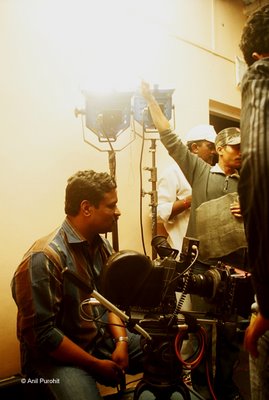
I sat on the floor beside Sanjay while he instructed the unit-hands on where to place the lights. He was looking for a sedate effect. It required him to improvise to fit his equipment in the space available, and there wasn’t much of it to go around. Earlier that day while they were filming the accident scene on the road that led up to the temple, I visited the temple and shared conversation with Satyaprakash Karambelkar, the temple caretaker. He had just finished up with scrubbing the floor when I walked in. Looking up at the statue of Lord Dattatreya now, my eyes almost reached up to the roof. Wires snaked all over the floor, leading to cameras, sound recorders, monitors, and to things I couldn’t quite identify in the jumble. Then the camera rolled. Ashish Ubale okayed the take before calling it a day after twelve straight hours of filming. All along, I watched from the sidelines, turning every once in a while to look at the Manori creek shimmering in the moonlight behind me, setting off the Mumbai skyline on the other side like a Christmas tree resting sideways, all decorated and nowhere to go.
Earlier in the day to get to Manori I took a ferry from Marwe after alighting from the train at Malad where I hired a rickshaw to Marwe, then sprinted across the beach just in time as the ferry pulled out from the beach and set off across the Manori creek that is fed by the Dahisar river draining into it. As I struggled to keep my balance, I remember thinking that beaches are the same everywhere, and that it is never easy running in the sand. Earlier, the train ride on the Western line from Borivali to Malad took me hardly any time. But to get to Borivali I boarded the Thane Muncipal Corporation (TMC) bus from Thane (West), passing through Ghodbunder, Kashimira, Mira Road, and Bhayander, taking me over an hour. I watched as the ferry cut through placid waters and deposited us at Manori fifteen minutes later where rickshaws were lined up to make a killing, charging twenty-five rupees to take me to Manori Talaav bus-stop, barely over a kilometer away. I sat out the time it took a BEST bus to drive over to the ferry point. I got in and sat by a window on the driver’s side of the bus. The bus was fairly empty. A group of Christian women sat in the front. On the ride along the waterfront, I passed fisherfolks, their homes, fishing nets, small fishing boats, and dugouts before getting off at Manori Taalav where the film unit was filming a ‘car scene’. Sanjay was behind the camera, shouting instructions every now and then while Nilesh Shetye scribbled in a notebook, keeping tab over scenes, takes, and the like. I went over to a shop at the intersection of four roads and got myself a cold drink. It was hot in the sun and it had taken me three and half hours of changing buses, trains, rickshaws, and ferry to get here. About then I heard Ashish call over the din, ‘Camera, Action’ as the cameras rolled. Then, ‘CUUUT.’ It was my first time this close at a film shoot.
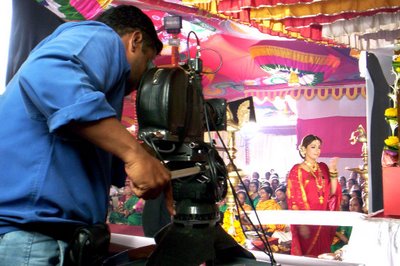
Sanjay Khanzode had a lot at stake in this film as did Ashish Ubale. The film also stars Vikram Gokhale, and Asavari Joshi. I missed out on the shoot involving Asavari Joshi. Sanjay was particularly happy about how that sequence turned out. "The lighting went well, and Asavari stands out wonderfully in her short cameo in the film," he told me later, and mailed me the picture above. The film was Sanjay’s first independent charge as a cinematographer after several assignments working in teams, sharing camera duties. Likewise, the film was Ashish’s first directorial venture after several stints as an Assistant Director. They both go back a long way to the same institute in Pune in the early Nineties when they passed out with a Diploma in their respective disciplines. I first met them in 1996 when they were staying at Yari Road in Versova, sharing their apartment with two others, each searching for a toehold in Bombay, like I was. Bombay was still Bombay in those days if you know what I mean. Over the years Sanjay and I kept in touch through M Satish, a mutual friend. By then Sanjay had shifted out of the Yari Road apartment to Thane, got married, kept up with a steady stream of assignments in Hindi, Marathi, and Punjabi television serials, music videos, documentaries, advertising films, and feature films. Jai Jai Gagangiri Maharaj was his first independent assignment as a cinematographer. Interestingly, Randhawa, a Punjabi, was producing the marathi language film, a fact not lost on Sanjay, a Maharashtrian brahmin. “It’s his first foray as a producer,” Sanjay told me.

Outside the room where the unit was filming a dream sequence featuring Gauri Karyekar, Randhawa sat patiently on a sofa in front of a monitor, his large face betraying nothing, while Sanjay passed instructions to the crew outside as they adjusted the cutter in front of the window, controlling the light streaming into the room from a powerful studio light source placed outside the window. Inside the small room, barely measuring eighteen feet by fifteen feet, I sat on a chair between Sanjay and Ashish watching silently while technicians went about their jobs, my camera loaded and ready.
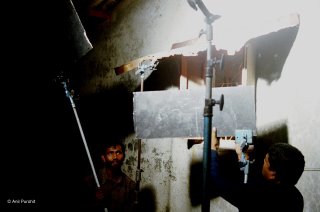 The room was transformed from an ordinary pad with a rustic bed and scattered items of everyday use, into a dark room with black curtains setting up the dream sequence featuring Gauri Karyekar, Rita Bhaduri’s other daughter-in-law in the film. Eventually, the cutter was in place lighting up Gauri to Sanjay’s satisfaction. The room tensed up in anticipation. Then, Ashish called out ‘Camera, ACTION. The camera rolled. Three takes later they canned the shot.
The room was transformed from an ordinary pad with a rustic bed and scattered items of everyday use, into a dark room with black curtains setting up the dream sequence featuring Gauri Karyekar, Rita Bhaduri’s other daughter-in-law in the film. Eventually, the cutter was in place lighting up Gauri to Sanjay’s satisfaction. The room tensed up in anticipation. Then, Ashish called out ‘Camera, ACTION. The camera rolled. Three takes later they canned the shot.
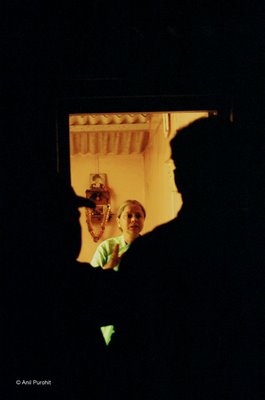 The film unit broke up for a round of poha and chai before getting back into the room to film the scene where Rita Bahaduri sees a vision of Gagangiri Maharaj, feeling his presence heal her of her ailment before hurrying to the door looking for the vision she just saw, a surprised look on her face. Then she heads for the temple, followed a little later by her daughter-in-law, Aishwarya, who comes looking for her on finding her bed empty.
The film unit broke up for a round of poha and chai before getting back into the room to film the scene where Rita Bahaduri sees a vision of Gagangiri Maharaj, feeling his presence heal her of her ailment before hurrying to the door looking for the vision she just saw, a surprised look on her face. Then she heads for the temple, followed a little later by her daughter-in-law, Aishwarya, who comes looking for her on finding her bed empty.
All the film sequences I saw that day were about lights and lighting. Sanjay went about methodically setting them up, displaying an innate ease that only comes from spending time with what you like doing, and doing it well.
When Sanjay left his hometown Akola for Mumbai, his first stint was with Debu Deodhar, the legendary cinematographer who filmed most of Amol Palekar’s films, starting with Ankahee (1984), Bangarwadi (1995), Daayraa (1997), Kairee (1999), to Anaahat (2003).
Speaking of those early days, Sanjay said, “Debuda said to me, ‘Sanjay, pehle backlight seekh lo,’ (Sanjay, first learn to use the backlight). Then he told me, ‘Understand why, for a camera position in a film sequence, the backlight is sourced from position A, and not from B.’ My learning curve took off from there.”
Sanjay started off on the sets of Sukhi Sansarachi Bara Sutra in the mid-nineties, a Satish Films production starring Ashok Saraf, the evergreen comedian from Marathi films, and Sanjay’s favourite actor. Debu Deodhar was the cinematographer, while Sanjay picked up the nuances, watching from a corner. It didn’t come easily. Remembering those early days, Sanjay said, “The first few days after the filming commenced all I did was make notes and diagrams of where the lights were placed for each scene in relation to the camera, and the subjects. I said nothing the whole day nor interfered with their work. Debuda noticed this and one day he called me over to his side and asked me what I was doing standing in a corner and making notes. I showed him the pages. Then he pointed to one of my diagrams and asked me, ‘Do you know why I’ve set up the lights in these positions?’ I replied, ‘No’. Then he said, ‘To know why is important. The day you learn why I’ve set up the lights in a particular way, you’ll have learned lighting. Once you learn lighting, it’ll mean you’re on your way to becoming a cameraman’,” Sanjay narrated, adding, “Tab se main kyun ke peeche lag gaya (Since that day I’ve been pursuing the ‘why’ of things.).”

Sanjay believes that many cinematographers in the film industry belong to the ‘Old School’, ‘Old’ as in their approach to lighting. “It has to do with the lack of adequate equipment, technology, and assistive tools like Video Assist in those days, limiting their scope, and forcing them to improvise, eventually shaping their approach. It’s not easy to change later.” Video Assist is mounted onto a movie camera (inside the viewfinder) to optically tap what the camera ‘sees’ and to transfer it to a monitor, usually placed away from the scene, where the director gets to see what the cinematographer is filming to ensure that the sequence is being shot exactly how he visualized and planned it. Video Assist came to be used widely in the Indian film industry in the Nineties. “But the advertising people got hold of it first,” Sanjay said. “Eventually the filmwallahs latched on to it.”
“Abhi aapko director kis tarah ka shot bataya, aur cameraman usko kis tarah se ley raha hai .... aapko monitor pe dikhta hai aaj, Video Assist hai (Today, the director can get to see how a cameraman executes his scene requirement on the monitor while he is filming it.),” Sanjay explained, continuing, “In the days before the monitor came to be widely used, when the Director described the scene to the cameraman, nobody except the cameraman knew what he was filming.”
Things were no different when Sanjay started off with Debu Deodhar. “I used to take permission from Debuda to peer through the viewfinder to see his frame compositions, querying him on his choice of lens for a given scene. It helped me to understand the role of lenses. Later, I tried predicting to myself the lens Debuda would use for each scene, to see if I’m getting the thinking right. Over a period of time I began to get my predictions correct most times. It was a step forward. I did the same with the lights,” he said.
“Kisi bhi shot mein lens ka selection important hai (In any film scene, the selection of the proper lens is important),” Sanjay said, adding, “Lens ka selection ke baad hee agey ka sab hoga, lighting hoga, trolley shot istemaal hogo, job hi baki ka techniques woh lens lagne ke baad hee hoga. Sab se pehla selection hai lens ka. Tho woh Director ko kya chahiye, aapko kis tarah ka scene establish karna hai, scene kis tarah se aagey progress hoga, woh isaab se lens ka selection hota hai. Shot actually choreograph hota hai. Tho ek scene ko kayee shot mein divide kartey hai apne requirement ke isaab se. Tho woh sabse important hai . . . lens ka selection.” As I listened to him, his words shook free in the night air and floated past, their passion powering them past me.
By then I was beginning to feeling thirsty. Back in the temple while they were filming the last sequence for the day, I had emptied the bottle of water I found on the window shelf. I suspect it belonged to the temple caretaker. Now I was feeling thirsty again. “Come over for the shoot at Madh tomorrow,” Sanjay said to me, tilting his face sideways so I could hear him over the rush of night air, and the phut-phutting of his bike. “Sure, I will try,” I replied.
The night air enveloped us as he took the left turn and headed out of Manori, towards Gorai. It was nearing midnight, and the roads were still. The wheels churned up the road as Sanjay picked up speed, slowing down as we came upon groups of people walking ahead, holding plastic chairs. It perplexed me to see so many people out on the road this late in the night. I wondered aloud to Sanjay if the Manori-Gorai stretch was readying for a film show out in the night, under open skies. Up ahead, over hundred people milled around a makeshift screen strung across the road, and held down by stones dangling from strings tied to corners of the screen to keep it from swaying in the stiff breeze blowing in from the west. People were gathered on either side of the screen, watching a black and white film. As we slowed down looking for a way past the open air film show, Sharmila Tagore made an entrance on the screen. Sanjay couldn’t help smiling. I held his suitcase tight while he negotiated the bike past people scattered all over the road. The stones brushed my leg as we squeezed past.
After we got to the other side of the screen I turned back to see the scene as it steadily receded behind us before disappearing after we took a right turn, slowing down at a speed-breaker. I doubt if I’ve ever ridden over the number of speed-breakers I did that night on the Manori-Gorai stretch. We had a long ride home, through Gorai, Mira Road, Ghodbunder, stopping over at a roadside stall for a cup of ice-cream.
“That is what I call spirit,” Sanjay said of those people enjoying an old hindi classic in the middle of a quiet road late in the night, opening the visor of his helmet so that I could hear him in the nip of night air rushing past.
“Yes,” I replied, rewinding to my memories of similar settings for films I saw under the open skies back in Goa. I particularly enjoyed Amitabh Bacchan’s Zanjeer in the backyard of an Electricity Sub-station long ago. It’s not an experience one easily forgets.
“They’ll never enjoy a film at Inox the way they’ll enjoy it out there in the open, under the night sky,” Sanjay said, “And that’s how a film should be seen.” His time back in Akola where he grew up aspiring of films were not very different from the rustic setting of Manori where people bring their chairs along for a film show on a road, or for that matter of my own memories of traveling theatres back in Almel, in North Karnataka, where they put up tents, advertised the film from a hand held loudspeaker and mounted on a bicycle, screened daily shows before moving on to the next village, repeating the same cycle all over again. I missed none of them on my vacations from school.
I went quiet for a while, lost in thought, and reflecting ‘Oh, to watch stars parade their talent on screen while stars ‘ride’ in the night sky many, many light-years away.’
Note 1 : The two pictures showing Sanjay Khanzode behind the camera filming Asavari Joshi (in red sari), and the scene in the balcony were passed on to me by Sanjay, the rest of the pictures I took during my time on the sets .
Note 2 : I got a sms from Sanjay today that said: 'Chandigarh me hu, punjabi film ka shooting chalu hai. Sab sardaronke sath me full timepass ho raha hai. 30th ko vapas . . .'


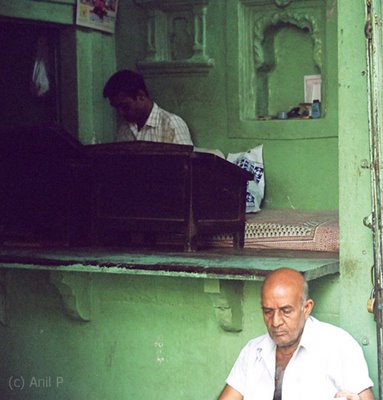

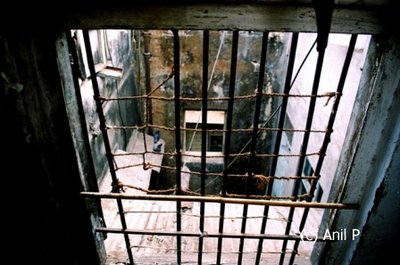

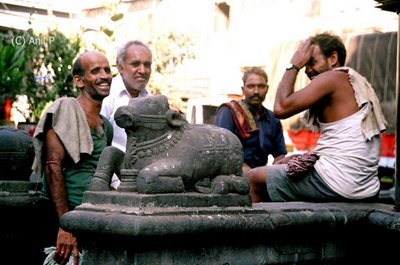
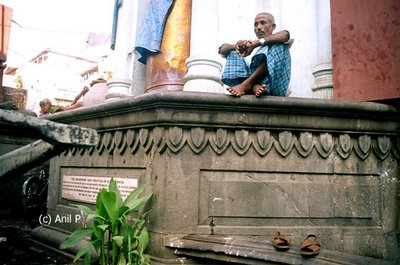
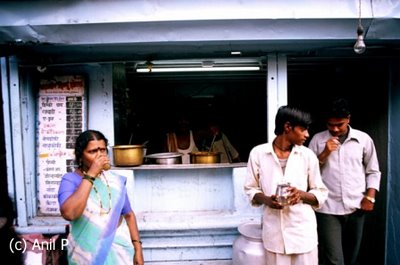 I walked past the fountain to what was essentially a chai shop but was named Mahavir Hindu Hotel. Pausing in front of the chai menu on a large board outside the shop, I mulled the choices of chai listed on the board.
I walked past the fountain to what was essentially a chai shop but was named Mahavir Hindu Hotel. Pausing in front of the chai menu on a large board outside the shop, I mulled the choices of chai listed on the board. I asked for Disco chai. The owner welcomed me in where I took a picture before drinking Disco chai. It tasted different though I couldn’t place my finger on what made it different. He smiled at me. I smiled back. Outside his shop, people sat nonchalantly on a wooden bench, watching the world go by while a truck emptied its load.
I asked for Disco chai. The owner welcomed me in where I took a picture before drinking Disco chai. It tasted different though I couldn’t place my finger on what made it different. He smiled at me. I smiled back. Outside his shop, people sat nonchalantly on a wooden bench, watching the world go by while a truck emptied its load.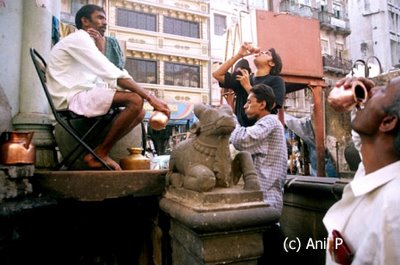 The previous day these lanes were choc bloc with people, some of whom had stopped by the fountain where a man in a loose fitting shirt with sleeves rolled up to the elbows sat on a folding chair on the fountain’s raised platform, a brass vessel in hand, and filling brass tumblers with water for thirsty passers-by. The man in green vest would pass the man on the chair brass pots filled with water from the water carrier which he placed by the side of the chair to fill the brass vessel that he used in pouring water into tumblers. Behind the fountain was the office of the Haath gaadi association. Several empty haath-gaadis were parked in front, and some of the haath gaadiwallahs operating in the area sat on a low platform, talking. There was a relaxed feel to the place.
The previous day these lanes were choc bloc with people, some of whom had stopped by the fountain where a man in a loose fitting shirt with sleeves rolled up to the elbows sat on a folding chair on the fountain’s raised platform, a brass vessel in hand, and filling brass tumblers with water for thirsty passers-by. The man in green vest would pass the man on the chair brass pots filled with water from the water carrier which he placed by the side of the chair to fill the brass vessel that he used in pouring water into tumblers. Behind the fountain was the office of the Haath gaadi association. Several empty haath-gaadis were parked in front, and some of the haath gaadiwallahs operating in the area sat on a low platform, talking. There was a relaxed feel to the place.

 I never attempted to bicycle to Tambdi Surla ever again. Once was enough.
I never attempted to bicycle to Tambdi Surla ever again. Once was enough.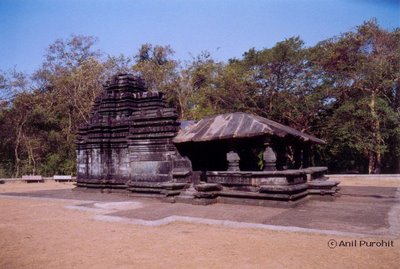 After I got off the scooter and thanked the scooterist for the ride, I walked the final stretch to the stone temple at Tambdi Surla, passing silent trees, and dodging the shadows they threw on the even quieter road. Traveling to Tambdi Surla, known to be home to the ‘only known specimen’ of Kadamba-Yadava architecture in basalt available in Goa, is a pilgrimage I’ve undertaken several times over the years. The fact that it nestles in the mountains, far away from tourist-traffic, often overwhelming, that other temples in Goa are witness to, starting with the end of monsoons in Oct-Nov, and petering off as Carnival comes around on the eve of the season of Lent when Christians fast and offer penance, makes it an attractive travel destination in my scheme of things. In two months time after the Carnival the first monsoon clouds wind their way across the Arabian Sea for their rendezvous with the Western Ghats. And I imagine the stone temple at Tambdi Surla, nestling in the Western Ghats mountain ranges, is among the first to welcome the monsoons to Goa.
After I got off the scooter and thanked the scooterist for the ride, I walked the final stretch to the stone temple at Tambdi Surla, passing silent trees, and dodging the shadows they threw on the even quieter road. Traveling to Tambdi Surla, known to be home to the ‘only known specimen’ of Kadamba-Yadava architecture in basalt available in Goa, is a pilgrimage I’ve undertaken several times over the years. The fact that it nestles in the mountains, far away from tourist-traffic, often overwhelming, that other temples in Goa are witness to, starting with the end of monsoons in Oct-Nov, and petering off as Carnival comes around on the eve of the season of Lent when Christians fast and offer penance, makes it an attractive travel destination in my scheme of things. In two months time after the Carnival the first monsoon clouds wind their way across the Arabian Sea for their rendezvous with the Western Ghats. And I imagine the stone temple at Tambdi Surla, nestling in the Western Ghats mountain ranges, is among the first to welcome the monsoons to Goa. The temple is situated in the Bhagwan Mahavir wildlife sanctuary. I particularly remember one trip when I was showing Jai around the place when he jumped up in alarm at seeing a Green Whip snake crossing his path. I set off in pursuit as it dodged stones and plants until I cornered it by blocking it path. Promptly it climbed up a small plant, curving up in classic Whip snake pose. As I moved cautiously in a semi circle, covering its exit, it swayed gently, as if undecided on its future course of action. It was a beautiful specimen; setting off its fluorescent green against the brown of the earth. I took pictures, framing it on the green plant. Then it left. However, photographing the Skink proved to be more difficult.
The temple is situated in the Bhagwan Mahavir wildlife sanctuary. I particularly remember one trip when I was showing Jai around the place when he jumped up in alarm at seeing a Green Whip snake crossing his path. I set off in pursuit as it dodged stones and plants until I cornered it by blocking it path. Promptly it climbed up a small plant, curving up in classic Whip snake pose. As I moved cautiously in a semi circle, covering its exit, it swayed gently, as if undecided on its future course of action. It was a beautiful specimen; setting off its fluorescent green against the brown of the earth. I took pictures, framing it on the green plant. Then it left. However, photographing the Skink proved to be more difficult.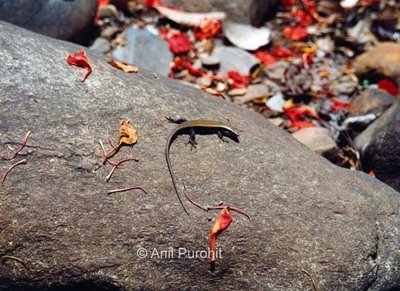 Where the road comes to an abrupt end not far from the tree, visitors cross a small bridge to get to the temple. From here, the temple unveils itself between branches of trees that crowd the cobbled path leading to the temple. In the spring of 2001, I took the flight of steps down to the dry stream bed in search of a Laughing Thrush whose call I had heard while exploring the length of the temple plot adjoining the stream. Instead, on rounded stones set off by brightly colored Gulmohar flowers blown free from Gulmohar trees on the banks of the stream, I saw several Skinks quick-stepping across the stones that littered the stream bed. It was awhile before I finally managed to take a picture of one skink basking on a stone amidst petals of Gulmohar flowers. By then I was sweating from chasing them only to find them disappear under the stones just when it appeared that I might pull off a good photograph.
Where the road comes to an abrupt end not far from the tree, visitors cross a small bridge to get to the temple. From here, the temple unveils itself between branches of trees that crowd the cobbled path leading to the temple. In the spring of 2001, I took the flight of steps down to the dry stream bed in search of a Laughing Thrush whose call I had heard while exploring the length of the temple plot adjoining the stream. Instead, on rounded stones set off by brightly colored Gulmohar flowers blown free from Gulmohar trees on the banks of the stream, I saw several Skinks quick-stepping across the stones that littered the stream bed. It was awhile before I finally managed to take a picture of one skink basking on a stone amidst petals of Gulmohar flowers. By then I was sweating from chasing them only to find them disappear under the stones just when it appeared that I might pull off a good photograph.

 As the shutter came down in a booming click, heightened by the silence, the Dragon fly took off.
As the shutter came down in a booming click, heightened by the silence, the Dragon fly took off.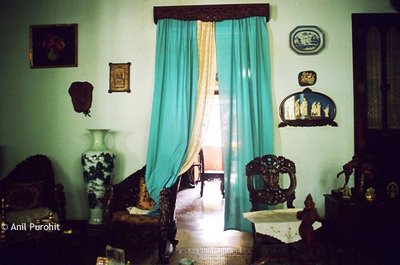



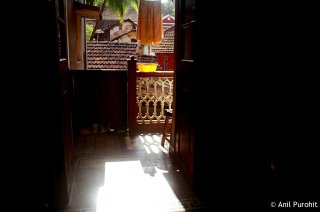
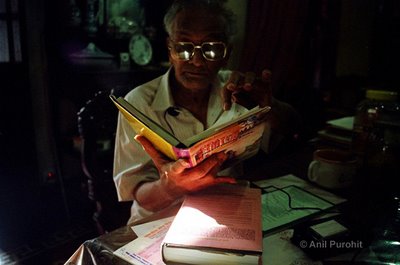






 As the train slows down on its approach to Ratnagiri, I trail my eyes over large factories set back from the tracks. From the train I can only imagine what they might be. It is a relief to emerge from the slew of tunnels and feel the warmth of sunshine streaming in through the windows.
As the train slows down on its approach to Ratnagiri, I trail my eyes over large factories set back from the tracks. From the train I can only imagine what they might be. It is a relief to emerge from the slew of tunnels and feel the warmth of sunshine streaming in through the windows.  The notice on the board reads
The notice on the board reads I buy Ratnagiri Times, the local marathi-language newspaper. A headline reports the Jodhpur court verdict sentencing the wayward film star Salman Khan to five years in jail for killing a Black Buck on a hunt in Rajasthan. The station resonates to conversations of people milling on the platform. An old lady gets into the train with a basket of bananas and looks up and down the length of the compartment to check if there’re sufficient passengers around to buy bananas. The train pulls out of the station, and later passes by houses with sloping roofs made of tiles and nestling among trees. Their walls are made of uncovered laterite stones. I steady my hand and take a few pictures. Past Ratnagiri, five more viaducts and three tunnels line the fifteen kilometer stretch between Ratnagiri and Nivasar. Of the five viaducts, the Panval Nadi viaduct, eight kilometers off Ratnagiri, spans 424 metres across the Panval river, and glides high over canopies below, and is among the tallest railway bridges in Asia, its piers rising sixty-four metres above the bed. As the train runs the length of the viaducts off Ratnagiri in quick succession I find myself riding valleys in the sky, keeping pace with pigeons riding the breeze alongside.
I buy Ratnagiri Times, the local marathi-language newspaper. A headline reports the Jodhpur court verdict sentencing the wayward film star Salman Khan to five years in jail for killing a Black Buck on a hunt in Rajasthan. The station resonates to conversations of people milling on the platform. An old lady gets into the train with a basket of bananas and looks up and down the length of the compartment to check if there’re sufficient passengers around to buy bananas. The train pulls out of the station, and later passes by houses with sloping roofs made of tiles and nestling among trees. Their walls are made of uncovered laterite stones. I steady my hand and take a few pictures. Past Ratnagiri, five more viaducts and three tunnels line the fifteen kilometer stretch between Ratnagiri and Nivasar. Of the five viaducts, the Panval Nadi viaduct, eight kilometers off Ratnagiri, spans 424 metres across the Panval river, and glides high over canopies below, and is among the tallest railway bridges in Asia, its piers rising sixty-four metres above the bed. As the train runs the length of the viaducts off Ratnagiri in quick succession I find myself riding valleys in the sky, keeping pace with pigeons riding the breeze alongside. 
















